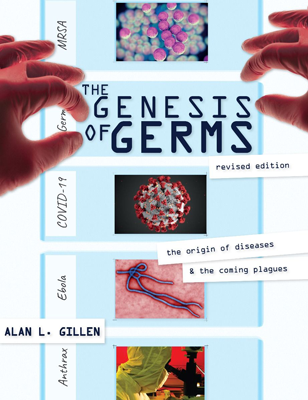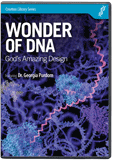
Chapter 34
Why Did God Make Viruses?
If God created everything good and with a purpose, why are there disease-causing bacteria and viruses in the world?

Author and professor Alan Gillen shows that constantly mutating diseases are proof for devolution rather than evolution.
There are some fundamental differences in how creationists and evolutionists view life. Biblical creationists believe that God created various forms of life according to their kinds with the ability to reproduce and fill the earth (Genesis 1:21– 22, 24–28). This view includes the concepts that God had purpose in what He created and that it originally was very good (Genesis 1:31; Isaiah 45:18).
In contrast, evolutionists view life as all descending from a single common ancestor by chance processes. Evolutionary arguments tend to imply that life isn’t really very complex or well designed. For example, 100 years ago a cell was promoted as being nothing more than a blob of protoplasm, implying that it wouldn’t be difficult for it to arise by chance. This proved to be wrong; cells are incredibly complex structures.1 At one time evolutionists argued that organs or structures with no known function actually had no function; at the time, this included hundreds of organs and structures in the human body. Instead, these were believed to be vestiges of evolution. This argument has become rather vestigial itself, as these organs have been found to have function.2
Yet this argument reappeared in genetics. Most of the DNA in our bodies does not code for proteins, so it was labeled “junk DNA” by evolutionists who assumed it has no function. As research continues, it is becoming clear that this DNA has numerous essential functions.3 The evolutionary worldview has a dismal track record for anticipating the astounding complexity in life uncovered by scientific research.
If God created everything good and with a purpose, why are there disease-causing bacteria and viruses in the world? It is true that we first learned about bacteria and viruses because of the problems they cause. Bacteria have been studied in considerable detail and are now recognized to be mainly helpful and absolutely essential for life on Earth; bacteria that cause disease (which developed as a result of the Fall) are the exceptions, not the rule.4 But what about viruses: what purpose could they possibly have?
What Is a Virus?
Viruses are a bit of an enigma. They contain DNA or RNA that are found in all living things. This is packaged in a protein coat. Despite this, viruses are not usually considered living because they are not made up of cells and cannot reproduce by themselves. Instead, the virus will inject the DNA or RNA into a living cell, and the cell will make copies of the virus and assemble them so they can spread.5
Given our current knowledge of viruses, it is quite reasonable to believe that disease-causing viruses are descended from viruses that were once not harmful.
Viruses vary considerably in their ability to cause disease. Many known viruses are not associated with disease at all. Others cause mild symptoms that may often go undetected. Some, like the HIV virus that causes AIDS in people, appear to have come from another species where they do not cause disease. Given our current knowledge of viruses, it is quite reasonable to believe that disease-causing viruses are descended from viruses that were once not harmful.6 It has been suggested that they have played an important role in maintaining life on Earth—somewhat similar to the way bacteria do.7 In fact, they may play a role in solving an intriguing puzzle that faces creationists.
A Creationist Puzzle
The biblical record tells of a global Flood when all created kinds of unclean land animals were reduced to a population of two, the pair that was preserved with Noah on the Ark (Genesis 7).8 After the Flood, these animals reproduced and filled the earth again (Genesis 8:15–19). Today, many of these kinds are represented by whole families. For example, the dog family (Canidae) is believed to represent a created kind.9 However, this is a very diverse group of animals. There are foxes that are adapted to living in the arctic, and others that live in the desert. There is incredible variety seen in modern domestic dog breeds. Where did all this variety come from? And how could it arise so quickly given that the Flood occurred around 4,300 years ago?10
The answer to this puzzle is probably quite complex. Some of the variety would have been carried by the pair of animals on the Ark. When parents pass traits on to their offspring, these traits can appear in new combinations in the offspring (Mendelian genetics). Natural selection can weed some existing traits out of a population. However, a close examination reveals that genetic changes have also arisen in this time.11 Many of these changes do not appear accidental and do not directly cause disease. For this reason, some creationists have proposed that God “designed animals to be able to undergo genetic mutations which would enable them to adapt to a wide range of environmental challenges while minimizing risk.”12
Isn’t That Evolution?
It is important to recognize that biologists use several distinct definitions for evolution that are often blurred together as if they are synonymous.13 Evolution is sometimes defined as “change in the genetic makeup (or gene frequency) of a population over time.” This has been observed; both creationists and evolutionists recognize this as important in building models to help us understand what likely happened in the past. A second definition of evolution involves the idea that all life descended from a common ancestor over millions of years through naturalistic processes. This has not been observed. In fact, it is in direct opposition to the testimony God (the eyewitness to creation) gives us in the Bible. The idea that all life has a common ancestor requires the assumption that the Bible’s history is false, and the assumption that changes which do occur could produce the variety of life we see today from a single-celled ancestor.14
The creation model predicts that degenerative changes can occur because mankind sinned and brought death into the world.
With regard to the first definition of evolution, creationists and evolutionists differ in the pattern of genetic changes they should expect to see. The creation model predicts that degenerative changes can occur because mankind sinned and brought death into the world (Genesis 3). It also predicts that adaptive changes could occur because God cares for His creation and intends for the earth to be inhabited (Psalm 147:8–9; Isaiah 45:18; Matthew 6:25–34). Both types of changes have been observed. The fact that some foxes are adapted to live in the arctic while others are adapted to live in the desert fits perfectly with this biblical teaching. While evolutionists accept that these types of changes occur, their model requires that most genetic changes add information to the genome. This pattern has not been observed. Without this pattern, they cannot account for the many organs and complex biochemical pathways that exist in animals today.15 Scientific observations show that there is an overall pattern of decay seen in the genome, which is the opposite of what the evolutionary model would predict.16
Another difference is the source of the genetic change. Evolutionists assume that random mutations and natural selection can account for the genetic changes that are seen. Since the underlying mechanism is naturalistic, changes were expected to be very slow. Contrary to their expectations, rapid adaptation has been observed,17 and evolutionists have had to adjust their thinking to accept this. Furthermore, detailed studies of the pattern in genetic differences within related animals don’t make sense if mutations are assumed to always be essentially random events.18 Something else is clearly going on here. It appears that God has placed some incredible programming into the genomes of the animals He created, and viruses may play some role in this.
Evidence of Horizontal Gene Transfer
Interestingly, there are some portions of DNA in animals that look like they came from a virus.19 While some of these were likely originally present in the genome since they have essential functions, others may have been introduced by viruses.20 A number of years ago, one creationist proposed that horizontal gene flow (genes picked up from somewhere in the environment rather than inherited from parents) may help to explain rapid adaptation and the interesting pattern of DNA in animals. In fact, the author lists 13 different biological phenomena that might be explained by horizontal gene flow.21 Since viruses carry genetic material (DNA or RNA), they are the most logical agents to suspect in transferring genes. While horizontal gene transfer would not change the identity of an animal (i.e., it would still belong to the same kind), it could rapidly provide a source of genetic variability that allows for rapid adaptation. If this is the case, then viruses were created “good” (as in Genesis 1), with a support role much like bacteria are known to have.
While the evidence is largely circumstantial, further scientific investigation does seem to support these ideas.22 In fact, a recent PNAS article has brought some new information to light. Previous studies had suggested horizontal transfer between closely related species. This study identified a large section of DNA (~2.9 kb) that was approximately 96 percent identical in a marsupial (opossum), several placentals (mouse, rat, bushbaby, tenrec, and little brown bat), a reptile (anole lizard), and an amphibian (African clawed frog). It was absent from the 27 other animals surveyed (which included human and Jamaican fruit bat). This sequence appears to have been incorporated into an existing functional gene in rats and mice, although its specific function is not yet known.23 Because of the pattern observed, it appears that horizontal gene transfer was concentrated at some time in the past and perhaps occurred via a DNA virus.24 Interestingly, several species (anole and opossum) are from Central/South America, several are restricted to Africa (bushbaby, tenrec), and the others have a wider geographical distribution.25 This suggests that the transfer may have occurred early post-Flood or been intercontinental in scope.26
Since most scientists are heavily influenced by the evolutionary worldview, they often miss indicators of purpose. For example, the section of DNA discussed above is a transposon (a type of mobile genetic element or transposable element). After the putative transfer, it was copied and integrated into several different parts of the genome in the various species. This requires that the proper tools (e.g., enzymes) be in place so that the section of DNA can be incorporated into the genome initially, then modified and copied appropriately. Given that decay has occurred over time, it is not surprising to creationists that there are examples of transposons where this process doesn’t work properly and disease occurs.
Diseases draw attention and research dollars, so the problems associated with transposons have been recognized before the benefits are understood (much like was true of bacteria). Many people still view these mobile genetic elements as “parasitic” or “selfish.” However, they are quite widespread in the genome of plants, animals, and man. If their insertion was always purely “random,” it seems they should more consistently cause problems in a complex system such as the genome.27 Therefore, it seems more logical to believe that transposons have purpose and were designed in a way to benefit their possessor.
The Bible Explains the Paradox
The biblical view explains an important paradox we see in the world around us. It anticipates the complexity that is constantly being uncovered by scientific research; God is an all-wise Creator and would be expected to use awesome design patterns and programming. It also explains the decay observed because mankind sinned and brought death into the world; the world is now in bondage to decay (Romans 8:20–21). This is an exciting time to be a creationist researcher, as the tremendous volume of scientific research is helping to provide answers to questions that have been asked for decades.
Editor’s note: Originally published in Answers in Depth 4 (2009), https://answersingenesis.org/answers/in-depth/v4/.
The New Answers Book 3
Do you have answers to the big questions about the Christian faith, evolution, creation, and the biblical worldview?
Read Online Buy BookFootnotes
- C. Wieland, “Chemical Soup Is Not Your Ancestor!” Creation 16 no. 2 (1994):46–47; see Harvard video, Inner life of a Cell at www.multimedia.mcb.harvard.edu/media.html.
- D. DeWitt, “Setting the Record Straight on Vestigial Organs,” www.answersingenesis.org/articles/aid/v3/n1/setting-record-straight-vestigial/; see chapter 24, “Vestigial Organs—Evidence for Evolution?” in this volume.
- G. Purdom, ““Junk” DNA—Past, Present, and Future, Part 1,” www.answersingenesis.org/articles/aid/v2/n1/junk-dna-part-1; J. Lightner, “The Smell of Change in Our Understanding of Pseudogenes,” www.answersingenesis.org/articles/aid/v3/n1/smell-of-change-pseudogenes.
- See chapter 31, “What About Bacteria?” in this volume.
- J. Bergman, “Did God Make Pathogenic Viruses?” Technical Journal 13 no. 1 (1999): 115– 125.
- J.R. Lucas and T.C. Wood, “The Origin of Viral Disease: A Foray into Creationist Virology,” in Exploring the History of Life: Proceedings of the Fifth BSG Conference and Occasional Papers of the BSG 8 (2006): 13.
- Bergman, “Did God Make Pathogenic Viruses?”; see chapter 31, “What About Bacteria?” in this volume.
- Unclean animals probably included all non-ruminants. See Leviticus 11; Deuteronomy 14:1–8.
- T.C. Wood, “The Current Status of Baraminology,” Creation Research Society Quarterly 43 no. 3 (2006): 149–158.
- J. Ussher, The Annals of the World, L. and M. Pierce, trans. and ed. (Green Forest, AR: Master Books, 2003).
- This is clear because the two animals on the Ark could carry up to four alleles for any one gene. Today there are some genes where considerably more than four alleles exist in animals from the same created kind.
- J.K. Lightner, “Karyotypic and Allelic Diversity in the Canid Baramin (Canidae),” Journal of Creation 23 no. 1 (2009): 94–98.
- See “An Introduction to Evolution” on the Understanding Evolution website, www.evolution.berkeley.edu/evolibrary/search/topicbrowse2.php?topic_id=41.
- See “Misconceptions about Evolution and the Mechanisms of Evolution: Evolution and Religion Are Incompatible” on the Understanding Evolution website, http://evolution.berkeley.edu/evolibrary/misconceptions_faq.php#h1. Note how religious beliefs are said to have nothing to do with the real (material) world; this is in stark contrast with the biblical teaching that God, as the Creator of all, is relevant to every aspect of life.
- See L. Spetner, Not By Chance! (New York, NY: Judaica Press, 1998).
- See J. Sanford, Genetic Entropy and the Mystery of the Genome (Lima, NY: Elim Publishing, 2005).
- See www.answersingenesis.org/articles/aid/v3/n1/life-designed-to-adapt.
- J.K. Lightner, “Karyotype Variability within the Cattle Monobaramin,” Answers Research Journal 1 (2008): 77–88; J.K. Lightner, “Genetics of Coat Color I,” Answers Research Journal 1 (2008): 109–166.
- Traditionally, this DNA has been assumed to be the result of viral infection. Recently, several creationists have presented evidence that some (RNA) viruses may actually be escapees. In other words, the genes were originally in the DNA of the animals and were able to move around within the cell (by copying on to RNA). At some point the viruses became independent and can now travel between animals. For more on this intriguing idea see Y. Liu. “The Natural History of Retroviruses” Answers Research Journal 2 (2009): 97–106.
- Y. Liu, “Were Retroviruses Created Good?” Answers, October–December 2006, online bonus content, www.answersingenesis.org/articles/am/v1/n2/were-retroviruses-created-good.
- T. Wood, “The Aging Process: Rapid Post-Flood Intrabaraminic Diversification Caused by Altruistic Genetic Elements (AGES),” Origins 54 (2002).
- T. Wood, “Perspectives on Aging: A Young Earth Creation Diversification Model,” in Proceedings of the Fifth International Conference on Creationism, Robert L. Ivey, Jr., ed. (Pittsburgh, PA: Creation Science Fellowship, 2003), p. 479–489.
- J.K. Pace II et al., “Repeated Horizontal Transfer of a DNA Transposon in Mammals and Other Tetrapods,” PNAS 105 no. 44 (2008): 17,023–17,028.
- The authors are evolutionists who carry in the assumption of common ancestry. Although creationists could argue that some kinds were created with these sequences and others were not, it appears more likely that they result from horizontal gene transfer. Also, the authors used evolutionary assumptions to estimate the time the horizontal transfer occurred (which was essentially the same for all species). When this type of estimate was done with mitochondrial DNA, the estimated mutation rate was significantly off compared to actual measured mutation rates. A. Gibbons, “Calibrating the Mitochondrial Clock,” Science 279 no. 5347 (1998): 28–29. Retrieved on October 24, 2008 from http://www.dnai.org/teacherguide/pdf/reference_romanovs.pdf.
- See comment by Cedric, one of the authors of the PNAS article, on “Space Invader DNA Jumped Across Mammalian Genomes,” www.scienceblogs.com/notrocketscience/2008/11/space_invader_dna_jumped_across
_mammalian_genomes.php. - The creation model predicts a high concentration of horizontal gene transfer post-Flood as animals were migrating out and filling various ecological niches. There is also a chance that animals on the Ark may have already carried these sequences. Further intrabaraminic comparisons may help to clarify the timing of horizontal gene flow for this particular case.
- Some accidental insertions may not cause obvious problems because the genome contains a high amount of redundancy. Redundancy is a hallmark of excellent design that militates against system failure. It is also inconsistent with the notion that life arose by chance. Such accidental insertions do, however, contribute to the deterioration of the genome.
Recommended Resources

Answers in Genesis is an apologetics ministry, dedicated to helping Christians defend their faith and proclaim the good news of Jesus Christ.
- Customer Service 800.778.3390
- Available Monday–Friday | 9 AM–5 PM ET
- © 2025 Answers in Genesis



